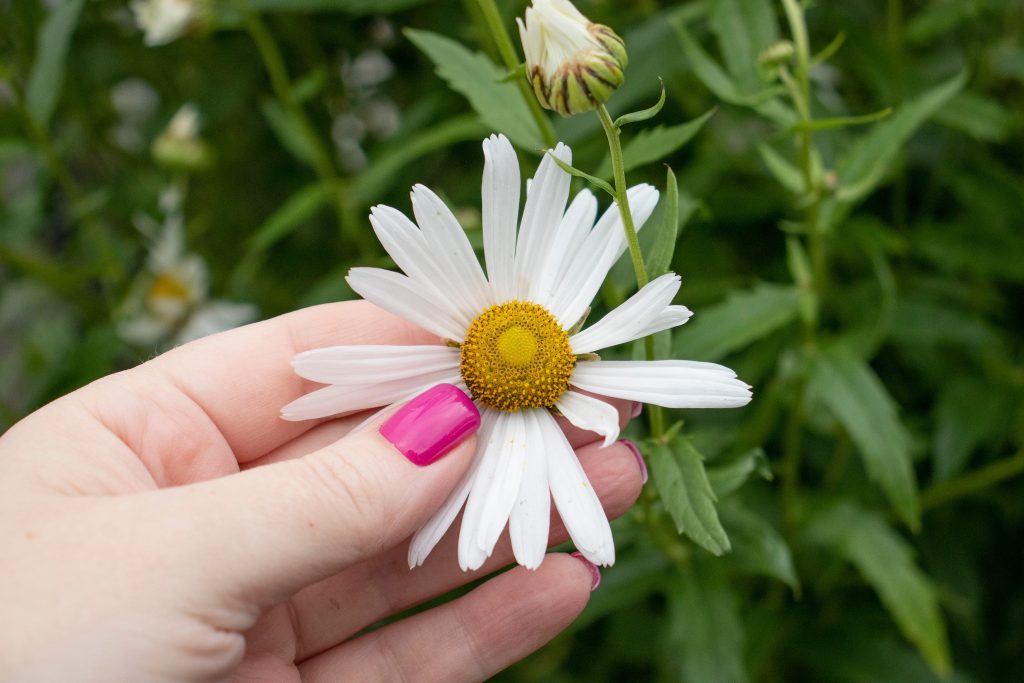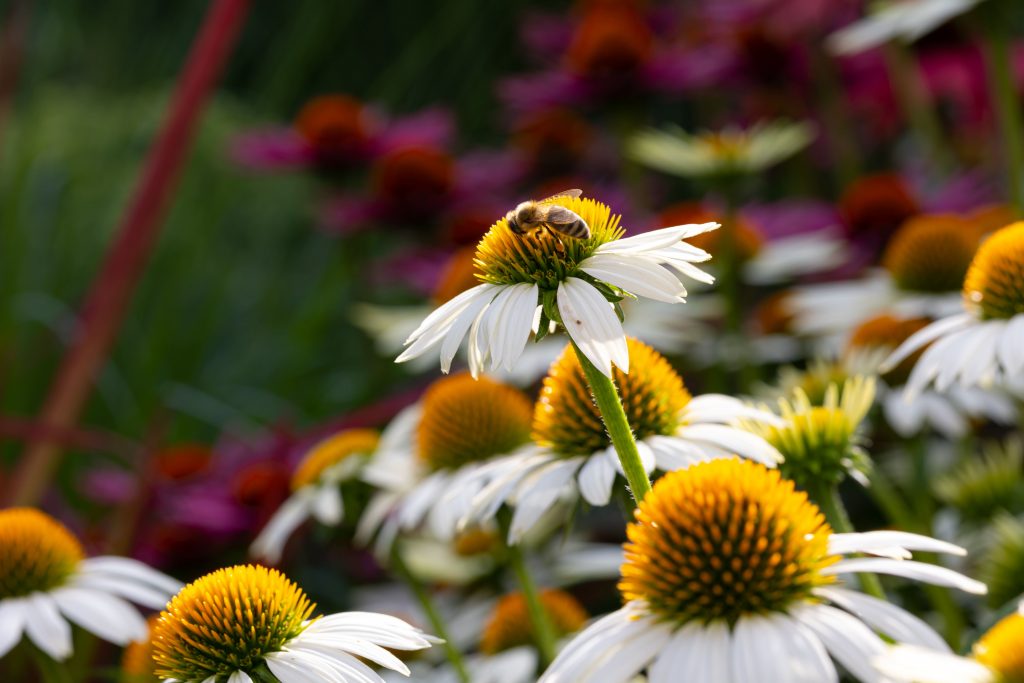I’m going to tell you about the five easiest flowers to take care of that will add color and beauty to your yard without taking a lot of your time. These flowers will make your outdoor space more peaceful and joyful, whether you are a new gardener or just want flowers that don’t require much care.
With these easy-to-care-for flowers, you can have a beautiful yard without having to worry about keeping it in good shape all the time. You will no longer have to pull weeds, water, and prune your garden all the time. Instead, your garden will pretty much take care of itself. Let’s explore the world of easy-to-care-for flowers and find the best ones to add to your yard.
White Daisies (Bellis Perennis)
White daisies, which are also called Bellis Perennis, are great for gardens that need little care. The soft white blooms of these lovely flowers add a splash of color to any yard. The fact that white daisies are very easy to grow and don’t need much care is one of their best qualities.
A lot of different types of soil will work for white daisies. They do best in soil that drains well. They do well in both full sun and light shade, which makes them useful in any yard. One great thing about white daisies is that they have a relatively small height, ranging from 6 to 30 inches tall. This makes them suitable for both flower beds and container planting.
When it comes to blooming, white daisies are some of the earliest spring flowers. They typically bloom in late winter to early spring, bringing much-needed color to your garden after a long, dull winter. Their white flowers stand in stark contrast to the often barren landscape of late winter, making them a sight for sore eyes.

Coreopsis (Coreopsis Grandiflora)
Coreopsis (Coreopsis Grandiflora), commonly known as tickseed, is a fantastic choice for a low-maintenance garden. One of the standout features of Coreopsis is its ability to thrive in poor and dry soils, making it perfect for areas where other plants may struggle. It is a drought-tolerant plant, meaning it can withstand periods of drought and still continue to bloom beautifully.
These low-maintenance plants have a long blooming period, often lasting from late spring to late summer. This extended period of bloom provides your garden with a continuous splash of color, without requiring much effort or attention on your part. Additionally, Coreopsis has the ability to self-seed, making it a self-sustaining perennial in your garden.
Coreopsis can be grown in a wide range of USDA hardiness zones, from zone 3 all the way to zone 9. This means that regardless of your location, you can enjoy the beauty and benefits of Coreopsis in your garden.
In terms of care, Coreopsis requires very little maintenance. It is relatively resistant to pests and diseases, alleviating the need for constant monitoring and interventions. Simply provide it with well-drained soil, and it will thrive even in challenging conditions.
Lavender (Lavandula Angustifolia)
Lavender (Lavandula angustifolia) is a beautiful and low-maintenance plant that is perfect for any garden. With its stunning purple blooms and fragrant flowers, lavender adds a touch of elegance and beauty to your outdoor space.
One of the best things about lavender is its ability to thrive in well-drained soil and full sun. This makes it an excellent choice for gardens with poor soil conditions, as lavender can tolerate a wide range of soil types. Whether you have sandy, rocky, or even clay soils, lavender will flourish with minimal effort on your part.
In terms of height, lavender typically grows to be around 20-24 inches tall, making it a great accent plant or border plant in your flower beds. Its blooming period extends from late June through August, attracting bees and butterflies with its showy flowers. Not only does lavender provide a stunning visual display, but it also helps to support pollinators in your garden.
When it comes to watering, lavender prefers to be watered deeply but infrequently. This is because lavender is drought tolerant, meaning it can withstand times of drought without needing constant watering. In fact, too much water can lead to root rot and other problems for this resilient plant. So, be sure to give lavender a good soak when you do water, then allow the soil to dry out before watering again.
Black-Eyed Susans (Rudbeckia)
Black-Eyed Susans, also known as Rudbeckia, are a popular choice for low-maintenance gardens. These bright and cheerful flowers are known for their vibrant yellow blooms with big brown-to-purple centers, creating a striking contrast in the garden.
One of the best things about Black-Eyed Susans is their ability to tolerate drought, making them a great choice for gardens with dry soil or those that experience periods of drought. These plants can withstand dry conditions without needing constant watering, making them an excellent choice for low-maintenance gardeners.
Another advantage of Black-Eyed Susans is their disease resistance. They are known to be hardy plants that are less prone to diseases or pests.
Additionally, Black-Eyed Susans attract butterflies, making them a great addition to pollinator gardens. These beautiful flowers not only add a splash of color to your garden but also support beneficial pollinators.
Keep in mind that Black-Eyed Susans may be a tasty treat for wildlife like rabbits or deer. To deter them, consider planting repellent plants like lavender or rosemary near your Black-Eyed Susans.
Coneflowers (Echinacea)
Coneflowers (Echinacea) are an excellent choice for a low-maintenance garden due to their hardiness and beautiful blooms. With a wide range of colors and variations in height and growth habits available, you can easily find the perfect coneflower to fit your garden’s aesthetic.
Once planted, coneflowers are quite low-key and require little attention. They are known for their resilience and ability to thrive in a variety of soil types, including poor soils. This makes them an ideal choice for gardeners who want a plant that can withstand less-than-ideal conditions. Whether you have well-drained soil or moist soil, coneflowers can adapt and flourish.
One of the most appealing characteristics of coneflowers is their long-lasting blooms. These showy flowers can bring vibrant colors to your garden from late spring to late summer. Not only are they visually stunning, but they also attract butterflies with their nectar-rich flowers. Watching these beautiful pollinators flit around your garden will surely bring joy to any nature lover.
Another advantage of planting coneflowers is their resistance to deer. These plants have a natural deterrent effect on deer, making them less likely to nibble on your garden. This is especially beneficial for those living in areas where deer sightings are common.

Conclusion
In conclusion, these top five flowers are excellent choices for a low-maintenance garden. Once established, they require minimal care, allowing you to sit back and enjoy their beauty without constantly tending to them. Occasional pruning and controlling their spread are the main tasks to keep them in check.
By incorporating these five best flowers for a low-maintenance garden, you can enjoy the benefits of beautiful blooms, versatile soil adaptability, and the attraction of pollinators, all while reducing the time and effort spent on maintenance. Sit back, relax, and let nature do its thing in your stunning and effortless flower garden.
